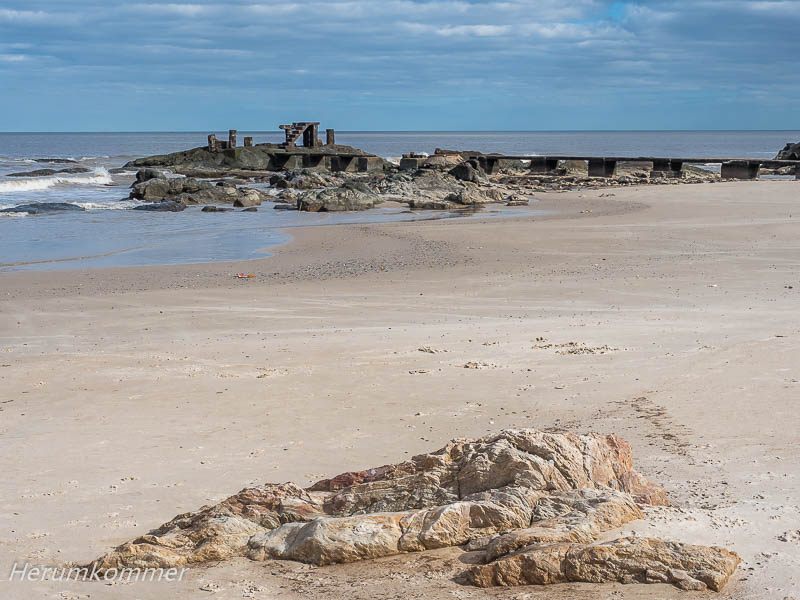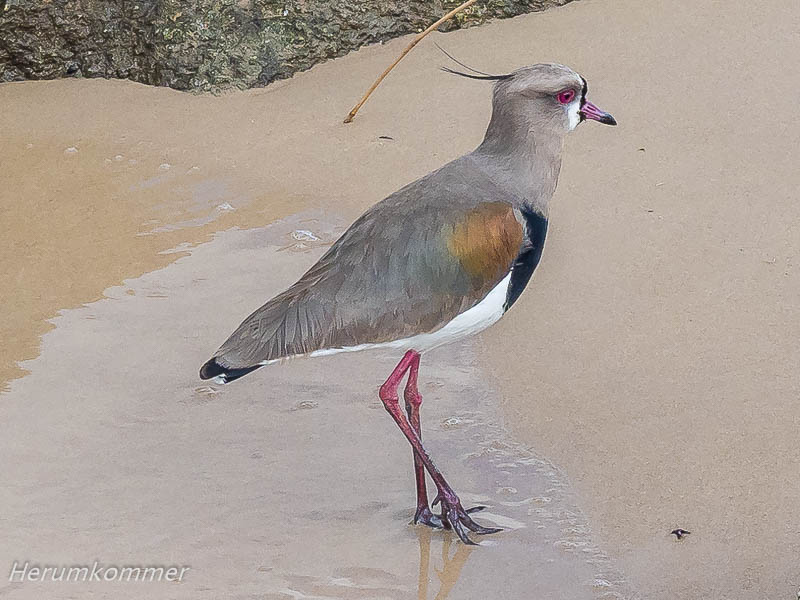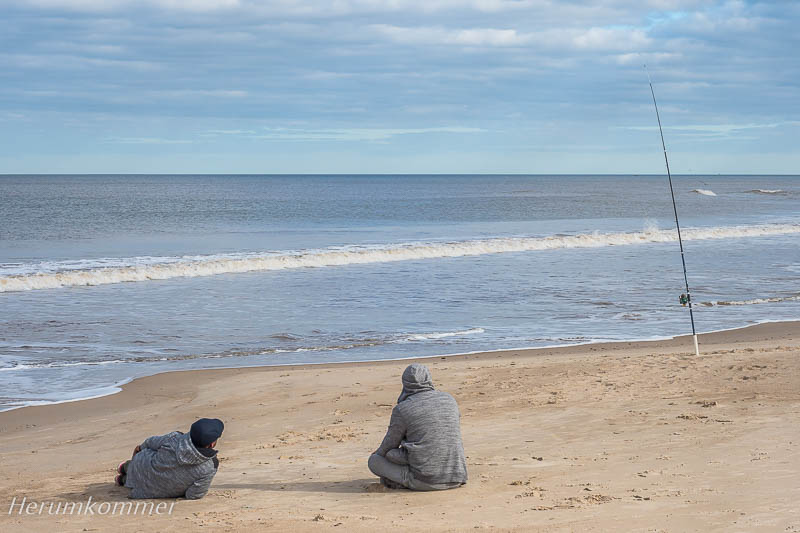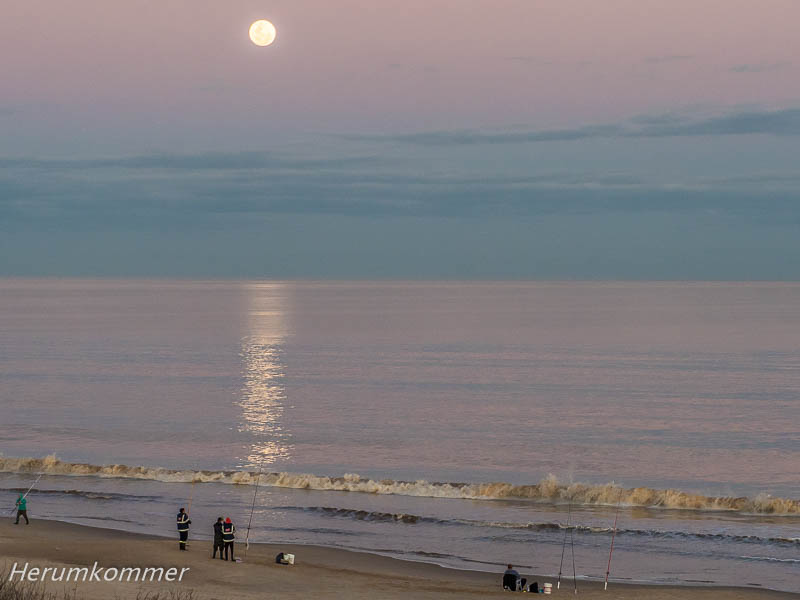
Mit nur einem Tag Verspätung haben wir unser Wohnmobil aus dem Hafen heraus bekommen. Dafür waren einige bürokratische Vorgänge erforderlich, die wir gleich am Tag unserer Ankunft in Montevideo erledigt haben: Bei der Einwanderungsbehörde(!) haben wir in der lange Schlange bis auf die Straße angestanden und ein „Zertifikat der Ankunft“ beantragt und bekommen. Das haben wir beim Zollagenten abgegeben. Der hat die Dokumente vom Fahrzeug und vom Halter kopiert und mit den Daten daraus einen Antrag an den Zoll gefertigt. Bei der Agentur der Reederei waren einige hundert US-Dollar zu bezahlen, dafür hat sie das Bill of Lading erstellt und dem Zollagenten übergeben. Als das Wohnmobil vom Schiff abgeladen war, hat der Zollagent mit den gesammelten Dokumenten die Freigabe des Fahrzeugs per E-Mail beantragt. Am selben Tag war sie abends erteilt.
Die Erleichterung war groß, als zu sehen war, dass das Womo unversehrt ist. Alle Türen und die großen Ausstellfenster waren mit Siegeln beklebt, die den Schriftzug „void“ (ungültig) hinterlassen, wenn sie gebrochen werden. Der Zoll hat innen alle Fächer geöffnet (die hatten wir, wie von Seabridge empfohlen, mit Klebestreifen fixiert, damit sich auf See nichts öffnet). In den Fächern war aber nichts durcheinander gebracht. Hundepfoten-Spuren im Womo lassen auf einen Drogenspürhund schließen.
Der Herumkommer hat dann zunächst Frau Rumkommer mit dem Fluggepäck aus der Hotel-Lobby geholt. Dann haben wir Frischwasser und Diesel getankt und die beiden Propangasflaschen füllen lassen. Danach war bis Einbruch der Dunkelheit gerade noch Einkaufen der nötigsten Lebensmittel möglich.
Einen guten Stellplatz haben wir dann am Rand von Montevideo gefunden. Nach Süden hin erstreckt sich von der Stadt eine Landzunge. An deren Ende steht der Leuchtturm Faro de Punta Carretas, umgeben von Felsen im Wasser. Direkt daneben ist eine Kläranlage, die „stört“. Aber ein paar hundert Meter nördlich sind viele gute Stellplätze, die augenscheinlich gern genommen werden.
At the Rio de la Plata
We got our motorhome out of the port with only one day’s delay. This required some bureaucratic procedures, which we took care of right on the day of our arrival in Montevideo: At the immigration office(!) we waited in the long queue all the way to the street and applied for and received a „certificate of arrival“. We handed it in to the customs agent. He copied the documents of the vehicle and the owner and prepared an application to customs with the data from them. We had to pay a few hundred US dollars to the shipping company’s agency, for which they prepared the Bill of Lading and handed it over to the customs agent. When the motorhome was unloaded from the ship, the customs agent used the collected documents to apply for the vehicle’s release by email. It was granted in the evening of the same day.
The relief was great when it was seen that the camper van was intact. All the doors and the large hinged windows had seals stuck on them, which leave the words „void“ if they are broken. Customs opened all the compartments inside (as recommended by Seabridge, we had fixed them with adhesive tape so that nothing would open at sea). But nothing was mixed up in the compartments. Dog paw marks in the camper suggest a drug-sniffing dog.
The Aroundgetter then first fetched Mrs Roundgetter with the flight luggage from the hotel lobby. Then we filled up with fresh water and diesel and had the two propane bottles filled. After that, it was just possible to go shopping for the most necessary groceries until nightfall.
We found a good pitch on the outskirts of Montevideo. To the south, a spit of land extends from the city. At its end is the Faro de Punta Carretas lighthouse, surrounded by rocks in the water. Right next to it is a sewage treatment plant that „disturbs“. But a few hundred metres to the north there are many good pitches that are apparently very popular.

.
.

.
.

.
.

.
Beim Blick auf den Rio de la Plata fällt es schwer zu glauben, dass es kein Meer sondern eine sehr breite Flussmündung ist. Kilometerlange Sandstrände gibt es hier, gelegentlich unterbrochen von Felsen. In Atlántida, einige Kilometer östlich von Montevideo, haben wir wieder eine große Auswahl an Stellplätzen, hier oberhalb des Strandes. Mitte August (entspricht Mitte Februar auf der Nordhalbkugel) blühen hier schon einige Sträucher. Gebadet wird hier jetzt selbstverständlich nicht, aber unzählige Angler sind am Strand aufgereiht. Am Abend erfreut uns sogar noch ein Vollmond über dem Wasser.
Looking at the Rio de la Plata, it is hard to believe that it is not a sea but a very wide estuary. There are kilometres of sandy beaches here, occasionally interrupted by rocks. In Atlántida, a few kilometres east of Montevideo, we again have a wide choice of pitches, here above the beach. In mid-August (equivalent to mid-February in the northern hemisphere), some shrubs are already in bloom here. Of course, there is no swimming here now, but countless anglers are lined up on the beach. In the evening, we even enjoy a full moon over the water.

.
.

.
.

.
.

.
.

.
.

.
.

.
.

.
.

.
.

.
.

.
.

.
.

.
Liebe Krim, lieber Reinhard,
dann hat ja alles wunderbar funktioniert. Gespannt werde ich Eure Reise verfolgen. Wir werden im September nach Rumänien aufbrechen und Eure Berichte als hilfreiche Inspiration nutzen.
Ich wünsche eine wunderbare Reise mit vielen neuen und bestimmt anderen Eindrücken, als von Euren bisherigen Reisen. Und ich wünsche mir wieder wunderbare Bilder, aber die macht Ihr ja sowieso.
Viele Grüße aus Franken, wo seit Wochen die ersten dicken Regentropfen fallen.
Peter Dirsch
Hallo Peter,
schön, mal wieder von dir zu hören.
Wir sind gespannt, wie euch Rumänien gefällt.
Herzliche Grüße, auch an Susanne, aus La Paloma,
Krim und Reinhard